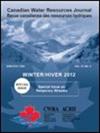Southern Quebec environmental flow assessments: spatial and temporal scales sensitivity
IF 0.9
4区 环境科学与生态学
Q3 WATER RESOURCES
引用次数: 5
Abstract
Abstract Faced with increasing demands for water withdrawals and a changing climate, the Quebec Department of Environment and Fight Against Climate Change is reviewing its water withdrawal guidelines to protect riverine ecosystems. For Southern Quebec, guidelines currently limit water withdrawals to a maximum of 15% of the 7Q2 (mean 7-day low flow with a return period of two years) during low flow periods. In this context, one of the issues raised is to investigate measures that help to preserve riverine ecosystems during low flow periods by establishing cut-off flow restrictions. This study compared eight low flow metrics to investigate which can be considered useful metrics to assess environmental flow in Southern Quebec rivers. Using 98 hydrometrics stations with a minimum of 20 years of daily flow data from eight hydrological regions, those low flow metrics were compared to three thresholds based on Tennant Method for monthly and annual temporal scales. The relevance of current hydrological regions delineation was investigated by looking at results within these regions, compared to six groups of stations defined using multivariate analyses. This study emphasizes that assessing environmental flows is linked to the hydrological context of the area of interest, the temporal scale of the historical data available, and the catchment size. The results showed that (1) winter low flows were lower than summer low flows; (2) 23% to 26% of the values were under the conservative thresholds for all the metrics depending of the time scale; and (3) the 7Q2, 7Q10 (mean 7-day low flow with a return period of ten years), Q95 and Q90 (95th and 90th percentile on the flow duration curve) are the less conservative for rivers having a low regime flow. To conclude, assessing several regionally adapted environmental flow metrics is recommended rather than systematically using the 7Q2 for Southern Quebec.南魁北克环境流量评价:空间和时间尺度敏感性
摘要面对日益增长的取水需求和不断变化的气候,魁北克省环境与应对气候变化部正在审查其取水指南,以保护河流生态系统。对于魁北克省南部,目前的指导方针将枯水期的取水量限制在7Q2(平均7天枯水期,重现期为两年)的15%以内。在这种情况下,提出的问题之一是调查通过制定断流限制措施来帮助在枯水期保护河流生态系统的措施。本研究比较了八个低流量指标进行调查,这些指标可被视为评估魁北克南部河流环境流量的有用指标。使用98个水文站,至少20个 根据八个水文区多年的日流量数据,将这些低流量指标与基于Tennant方法的三个阈值进行了比较,分别用于月度和年度时间尺度。通过查看这些区域内的结果,与使用多元分析定义的六组站点进行比较,来调查当前水文区域划分的相关性。这项研究强调,评估环境流量与感兴趣区域的水文背景、可用历史数据的时间尺度和集水区规模有关。结果表明:(1)冬季低流量低于夏季低流量;(2) 对于取决于时间尺度的所有度量,23%至26%的值低于保守阈值;以及(3)对于具有低状态流量的河流,7Q2、7Q10(具有10年重现期的平均7天低流量)、Q95和Q90(流量-持续时间曲线上的第95和第90百分位)是不那么保守的。总之,建议评估几个区域适应的环境流量指标,而不是系统地使用魁北克南部的7Q2。
本文章由计算机程序翻译,如有差异,请以英文原文为准。
求助全文
约1分钟内获得全文
求助全文
来源期刊

Canadian Water Resources Journal
WATER RESOURCES-
CiteScore
2.90
自引率
5.90%
发文量
17
审稿时长
>12 weeks
期刊介绍:
The Canadian Water Resources Journal accepts manuscripts in English or French and publishes abstracts in both official languages. Preference is given to manuscripts focusing on science and policy aspects of Canadian water management. Specifically, manuscripts should stimulate public awareness and understanding of Canada''s water resources, encourage recognition of the high priority of water as a resource, and provide new or increased knowledge on some aspect of Canada''s water.
The Canadian Water Resources Journal was first published in the fall of 1976 and it has grown in stature to be recognized as a quality and important publication in the water resources field.
 求助内容:
求助内容: 应助结果提醒方式:
应助结果提醒方式:


